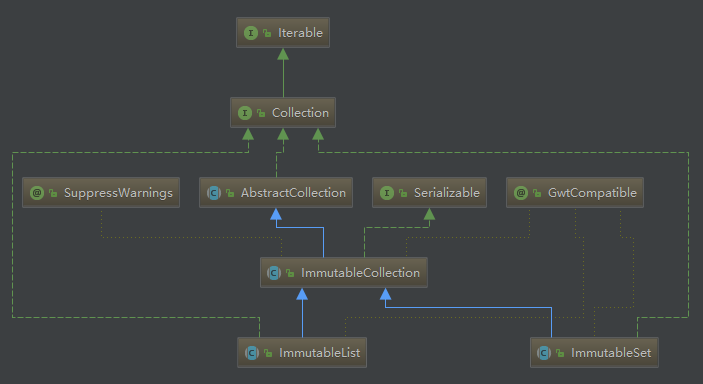Guava源码学习(三)ImmutableCollection
基于版本:Guava 22.0
0. ImmutableCollection简介
类似于JDK的Collections.unmodifiableXXX,可以创建不可变集合,是一种防御式编程的体现。
1. 类图

这张类图也不完全,ImmutableCollection实际上有十几个子类
2. 设计思路
ImmutableCollection是继承于Collection的抽象类,将所有涉及到修改的方法全部设置为final(禁止子类重写),方法体是直接抛出UnsupportedOperationException。
这样就实现了禁止修改的语义。
随意举两个例子如下:
/** * Guaranteed to throw an exception and leave the collection unmodified. * * @throws UnsupportedOperationException always * @deprecated Unsupported operation. */ @CanIgnoreReturnValue @Deprecated @Override public final boolean add(E e) { throw new UnsupportedOperationException(); } /** * Guaranteed to throw an exception and leave the collection unmodified. * * @throws UnsupportedOperationException always * @deprecated Unsupported operation. */ @CanIgnoreReturnValue @Deprecated @Override public final boolean remove(Object object) { throw new UnsupportedOperationException(); }
但是如何初始化ImmutableCollection呢?
a. ImmutableCollection的子类都实现了of与copyOf方法,通过这两个方法可以直接获取ImmutableCollection的实例。
b. ImmutableCollection.Builder提供了更加方便的构造器,ImmutableCollection的子类通过实现ImmutableCollection.Builder的关键方法,可以创建ImmutableCollection的实例。
3. ImmutableList
简单分析一下ImmutableList的实现
public static <E> ImmutableList<E> copyOf(Collection<? extends E> elements) { if (elements instanceof ImmutableCollection) { @SuppressWarnings("unchecked") // all supported methods are covariant ImmutableList<E> list = ((ImmutableCollection<E>) elements).asList(); return list.isPartialView() ? ImmutableList.<E>asImmutableList(list.toArray()) : list; } return construct(elements.toArray()); }
这个copyOf方法是很有意思的:
如果发现传入的集合是ImmutableCollection,并且不是完全的集合(由subList这种方法创建的集合),则创建一个拷贝(不再保留对原集合的引用,如果原集合很大,可以减少内存泄漏的可能),如果是完全的集合,则直接返回它的引用。
/** * Returns an immutable list of the elements between the specified {@code * fromIndex}, inclusive, and {@code toIndex}, exclusive. (If {@code * fromIndex} and {@code toIndex} are equal, the empty immutable list is * returned.) */ @Override public ImmutableList<E> subList(int fromIndex, int toIndex) { checkPositionIndexes(fromIndex, toIndex, size()); int length = toIndex - fromIndex; if (length == size()) {//直接返回整个引用 return this; } else if (length == 0) { return of();//返回EMPTY } else { return subListUnchecked(fromIndex, toIndex);//创建subList } } /** * Called by the default implementation of {@link #subList} when {@code * toIndex - fromIndex > 1}, after index validation has already been * performed. */ ImmutableList<E> subListUnchecked(int fromIndex, int toIndex) { return new SubList(fromIndex, toIndex - fromIndex);//限定subList的范围 } class SubList extends ImmutableList<E> { final transient int offset; final transient int length; SubList(int offset, int length) { this.offset = offset; this.length = length; } @Override public int size() { return length; } @Override public E get(int index) {//转换下标,从原list的对应位置取值 checkElementIndex(index, length); return ImmutableList.this.get(index + offset); } @Override public ImmutableList<E> subList(int fromIndex, int toIndex) { checkPositionIndexes(fromIndex, toIndex, length); return ImmutableList.this.subList(fromIndex + offset, toIndex + offset); } @Override boolean isPartialView() {//标注这是一个不完整的集合 return true; } }
ImmutableList.subList方法的实现,没有创建ImmutableList的副本,而是直接访问原ImmutableList中的元素,当然中间会进行下标的转换。
由于ImmutableList是不可变的,所以这样做是非常安全的,而且节省了开销。
4. 与Collections.unmodifiableXXX的区别
-
unwieldy and verbose; unpleasant to use everywhere you want to make defensive copies
-
unsafe: the returned collections are only truly immutable if nobody holds a reference to the original collection
-
inefficient: the data structures still have all the overhead of mutable collections, including concurrent modification checks, extra space in hash tables, etc.
直接引用并发编程网的翻译如下
-
笨重而且累赘:不能舒适地用在所有想做防御性拷贝的场景;
-
不安全:要保证没人通过原集合的引用进行修改,返回的集合才是事实上不可变的;
-
低效:包装过的集合仍然保有可变集合的开销,比如并发修改的检查、散列表的额外空间,等等。




